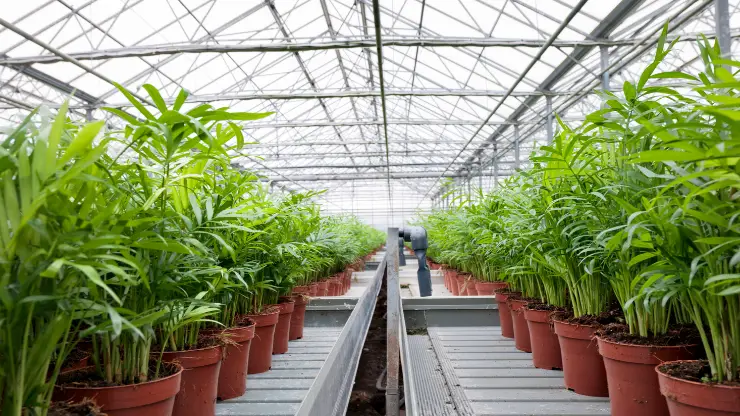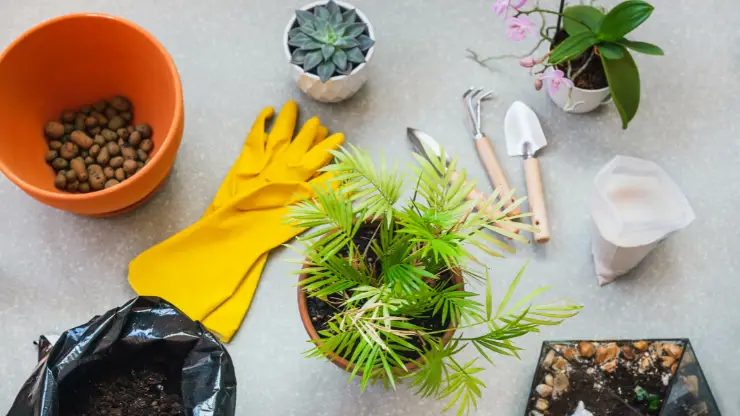
Neanthe bella palm (Chamaedorea elegans), also known as parlor palm, is an easy-care indoor tree that tolerates low light and occasional neglect. It’s been popular as a houseplant since the early 1800s for its ability to thrive in dark Victorian parlors (hence the common name).
Fully mature neanthe bella palms reach 4 feet (1.2 meters) high and 3 feet (.9 meters) wide, making them a great choice for large, empty areas in your home. With proper care, they produce numerous attractive green leaves with multiple narrow leaflets on each side.
In this post, I’ll cover all aspects of neanthe bella palm care indoors – including how to keep them happy and thriving for 10 years or more in your home.
Neanthe Bella Palm Care Indoors
Neanthe bella palm is one of the easiest palms to care for indoors. It tolerates low light and dry conditions much better than other palms. Here’s a brief rundown of its care requirements:
- WATER – When top 1-inch of soil dries out
- HUMIDITY – Moderate
- FEEDING – Monthly, spring and summer
- LIGHT – Low to medium
- TEMPERATURE – 65 – 80 degrees F (18 – 27 degrees C)
- SAFETY – Non-toxic, safe for children and pets
- DIFFICULTY – Easy
Keep reading for more in-depth care information, including how to feed, re-pot, propagate and maintain your neanthe bella palm. Plus, I’ll cover some troubleshooting information if your plant appears to be struggling.
Water
One of the most important parts of neanthe bella palm care indoors is watering. Water any time the top 1 inch of soil dries out (about once every 7 – 10 days). It’s important not to over-water, as this palm recovers from occasional dryness much better than from extremely wet conditions.
Test soil moisture by inserting your finger directly into the soil up to your first knuckle. If the soil feels dry, give your plant some water. If it feels moist, wait another day and check again. Moisture is important, but too much water will kill your palm – so don’t over-do it!
Humidity
Although neanthe bella palms can tolerate dry indoor air, they’re healthier when provided with moderate humidity. Mist your palm a few times a week with a spray bottle filled with room temperature water to prevent leaves from drying out.
You can also place smaller neanthe bella palms on a humidity tray (a small tray filled with pebbles and water) to increase humidity. Or, place a high-quality humidifier in the room near the plant. I like to use the Honeywell Coolmist humidifier for my humidity-loving houseplants.

Fertilizer
Neanthe bella palms need a little more fertilizer than other indoor palms – especially in summer when the plant is actively growing. Use any good quality fertilizer formulated for houseplants. Apply at half strength once a month during spring and summer. Do not feed in fall and winter.
My favorite houseplant fertilizer is Jack’s All-Purpose Fertilizer, but any all-purpose food will work. Read my review of Jack’s Fertilizer to see why I love it so much. I use it on almost all my houseplants except those that require special nutrients – like cacti and flowering plants.
Light Requirements
Neanthe bella palms adapt well to low light, although they prefer moderate light. For the best results, place in an east-facing window or a west-facing window with the light filtered by gauzy curtains. They also grow nicely under artificial plant lights.
Avoid direct sunlight. And don’t place neanthe bella palm in south-facing windows, as the hot afternoon sun might burn the plant’s delicate leaves. It can be placed outdoors in the summer if temperatures aren’t too high, but make sure it’s in a shady spot out of direct sun.
Temperature
Neanthe bella palm temperature requirements are average to warm. This plant likes temperatures around 65 – 80 degrees F (18 – 27 degrees C) all year. It can tolerate temperatures as low as 60 degrees F (15 degrees C) at night, but it will need to warm back up in the day time.
As a tropical plant, this palm does not like cold temperatures. Make sure to never allow it to get too cold (under 60 degrees F/15 degrees C) for long periods, or your plant may not recover. Keep it away from drafts and blasts of hot air from heating vents.
Potting
Use any organic, well-draining potting soil formulated for houseplants. My favorite is this one by Happy Frog because it contains mycorrhizal fungi and beneficial soil microbes, but any high-quality potting mix with good drainage will work.
Re-pot young, actively growing palms yearly in early spring. Once your palm is mature, it only needs to be re-potted every other year until it reaches full size (about 4 feet or 1.2 meters tall). When re-potting, shift up to a container at least 4 inches in diameter larger than the current pot.
Propagation
Neanthe bella palm is propagated from seed, but this method is not recommended for most houseplant growers. If you want a second plant, I recommend buying a new one that’s been propagated by a nursery. (See “Where to Buy” section below.)

Maintenance
Clean neanthe bella palm’s leaves by hand occasionally to remove dust and prevent spider mite infestation. You can also give them a shower when watering once a month or so. I take mine into the bathtub and spray it down (gently) with lukewarm water once every 4 – 6 weeks.
Neanthe bella palm will typically flower indoors when given proper care – once the plant is about three years old. However, the seeds that follow are usually not fertile, so just clip off the flower stalks when they start to turn brown.
Troubleshooting
Here are some common problems houseplant growers often encounter when growing neanthe bella palm indoors and solutions for how to fix them.
Neanthe Bella Palm Dry Leaves – If leaves are dry and/or leaf tips turn brown, the air near your plant is probably too dry. Increase humidity by misting your neanthe bella palm regularly with room temperature water, placing on a humidity tray, or placing near a humidifier.
RELATED: How to Increase Humidity for Plants Without a Humidifier
Neanthe Bella Palm Leaves Turning Brown – our neanthe bella palm leaves are turning brown, this is most likely due to too much sunlight exposure. Make sure to keep the plant out of direct sunlight. An east-facing window is the ideal location.
Related Questions
Here are some frequently asked questions related to neanthe bella palm care indoors that you might find helpful (plus my answers to them).
How Much Light Does a Neanthe Bella Palm Need?
Neanthe bella palms need bright indirect light, and never direct sun. The best location is in an east-facing window or a west-facing window with the light filtered by sheer curtains.
Do not place neanthe bella palm in south-facing windows. It can tolerate low light conditions (such as from a north-facing window), but will not be as strong or grow as quickly.
How Do You Care for a Neanthe Bella Palm?
To provide the best possible neanthe bella palm care indoors, here’s what to do:
- Give the plant bright indirect light from an east-facing window.
- Mist regularly with room temperature water.
- Feed once monthly with a balanced houseplant fertilizer diluted to half strength during spring and summer.
- Keep temperatures warm.
- Clean leaves regularly by hand.
- Snip off flower stalks when they turn brown.

Is a Neanthe Bella Palm Easy to Care For?
Yes, neanthe bella palm is one of the easiest indoor palms to care for. It can tolerate low light and dry conditions much better than other types of palms. Plus, it is low maintenance.
Clean its leaves occasionally, water once a week or so, mist a few times a week, and feed monthly during the spring and summer. Aside from that, a good location is all it needs!
How Big Will a Neanthe Bella Palm Get?
A fully mature neanthe bella palm can grow to 4 feet (1.2 meters) high and 3 feet (.9 meters) wide indoors. It’s a great plant to place behind a sofa or in a big, empty area of your home.
In the wild, neanthe bella palm can reach heights of up to 16 feet (5 meters), though it doesn’t often get much taller than around 9 feet (2.7 meters).
Does a Neanthe Bella Palm Produce Seeds?
Yes, neanthe bella palm does produce seeds. Once the plant is about three years old, it often produces flowers – even when grown indoors as a houseplant. The seeds that follow flowering, however, are often not fertile. You can try to plant them, but you may not have success.
I recommend simply snipping off the flower stalks after they start to turn brown, and not wasting your time trying to plant the seeds. (But it won’t hurt anything if you want to try.)
Where to Buy Neanthe Bella Palm
Neanthe bella palm (also known as parlor palm) is an extremely popular houseplant due to its beauty and ease of care. As such, you should be able to find it for sale in local nurseries and garden centers nearly year round. I think my local Walmart almost always has them in stock.
If for some reason you can’t find a neanthe bella palm for sale locally, you can always check the listings on Etsy. This is my go-to place for buying hard-to-find houseplants.
I like supporting small growers since they seem to care more about their reputation and have better quality plants than most large, online mega-nurseries. I also love the variety you can find on Etsy, with many exotic cultivars you may never see locally.
Click here to check the current Etsy listings for neanthe bella palm. Good luck and happy growing!




